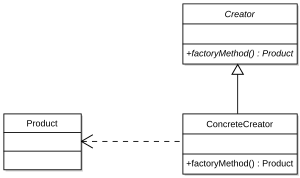Factory method pattern
2008-08-25 11:43
393 查看
Factory method pattern
From Wikipedia, the free encyclopedia


Factory method in UML


Factory Method in LePUS3
The factory method pattern is an object-oriented design pattern. Like other creational patterns, it deals with the problem of creating objects (products) without specifying the exact class of object that will be created. The factory method design pattern handles this problem by defining a separate method for creating the objects, which subclasses can then override to specify the derived type of product that will be created. More generally, the term factory method is often used to refer to any method whose main purpose is creation of objects.
Definition
The essence of the Factory Pattern is to "Define an interface for creating an object, but let the subclasses decide which class to instantiate. The Factory method lets a class defer instantiation to subclasses."Common usage
Factory methods are common in toolkits and frameworks where library code needs to create objects of types which may be subclassed by applications using the framework.Parallel class hierarchies often require objects from one hierarchy to be able to create appropriate objects from another.
Other benefits and variants
Although the motivation behind the factory method pattern is to allow subclasses to choose which type of object to create, there are other benefits to using factory methods, many of which do not depend on subclassing. Therefore, it is common to define "factory methods" that are not polymorphic to create objects in order to gain these other benefits. Such methods are often static.Encapsulation
Factory methods encapsulate the creation of objects. This can be useful if the creation process is very complex, for example if it depends on settings in configuration files or on user input.Consider as an example a program to read image files and make thumbnails out of them. The program supports different image formats, represented by a reader class for each format:
ImageReader DecodedImage getDecodedImage; GifReader ImageReader GifReader in DecodedImage getDecodedImage decodedImage; JpegReader ImageReader
Each time the program reads an image it needs to create a reader of the appropriate type based on some information in the file. This logic can be encapsulated in a factory method:
ImageReaderFactory ImageReader getImageReader is imageType = figureOutImageType is ; imageType ImageReaderFactory.: GifReader is ; ImageReaderFactory.: JpegReader is ;
The code fragment in the previous example uses a switch statement to associate an
imageTypewith a specific factory object. Alternatively, this association could also be implemented as a mapping. This would allow the switch statement to be replaced with an associative array lookup.
Limitations
There are three limitations associated with the use of the factory method. The first relates to refactoring existing code; the other two relate to inheritance.The first limitation is that refactoring an existing class to use factories breaks existing clients. For example, if class Complex was a standard class, it might have numerous clients with code like:
Complex c = Complex, ;
Once we realize that two different factories are needed, we change the class (to the code shown earlier). But since the constructor is now private, the existing client code no longer compiles. The second limitation is that, since the pattern relies on using a private constructor, the class cannot be extended. Any subclass must invoke the inherited constructor, but this cannot be done if that constructor is private.
The third limitation is that, if we do extend the class (e.g., by making the constructor protected -- this is risky but possible), the subclass must provide its own re-implementation of all factory methods with exactly the same signatures. For example, if class StrangeComplex extends Complex, then unless StrangeComplex provides its own version of all factory methods, the call StrangeComplex.fromPolar(1, pi) will yield an instance of Complex (the superclass) rather than the expected instance of the subclass.
All three problems could be alleviated by altering the underlying programming language to make factories first-class class members (rather than using the design pattern).
Examples
C#
Pizza example:abstract Pizza abstract GetPrice; Types HamMushroom, Deluxe, Seafood Pizza PizzaFactoryTypes t t Types.: HamAndMushroomPizza; Types.: DeluxePizza; Types.: SeafoodPizza; . + t. + ; HamAndMushroomPizza : Pizza m_Price = .5M; GetPrice m_Price; DeluxePizza : Pizza m_Price = .5M; GetPrice m_Price; SeafoodPizza : Pizza m_Price = .5M; GetPrice m_Price; ... . Pizza.Pizza.... ; ...
JavaScript
Pizza example:HamAndMushroomPizza price = ; . = price; DeluxePizza price = ; . = price; SeafoodPizza price = ; . = price; PizzaFactory . = type type : HamAndMushroomPizza; : DeluxePizza; : SeafoodPizza; : DeluxePizza; pizzaPrice = PizzaFactory..; pizzaPrice;
Python
createAcreateBcreateCimportSerializationimportSerializationimportSerialization<interactive input> functools partial, wraps Factory: register, methodName, constructor, *args, **kwds: _args = constructor _args.args , methodName, wrapsmethodNamepartialFunctor,*_args, **kwds unregister, methodName: , methodName
相关文章推荐
- DesignPattern_Java:Factory Method Pattern
- C#设计模式(5)-Factory Method Pattern
- 工厂方法模式FactoryMethodPattern
- C#设计模式(5)-Factory Method Pattern
- Swift 01 工厂方法模式 Factory method pattern
- 工厂模式【Factory  Method  Pattern】
- Design Pattern 3: Factory Method && Abstract Factory Pattern
- 设计模式系列(四)简单工厂模式(Simple Factory Pattern/Static Factory Method)
- 设计模式2:Factory Method Pattern(工厂方法模式)
- 简单工厂模式(Simple Factory Method Pattern)
- C#设计模式(5)-Factory Method Pattern
- Factory Method Pattern
- C#设计模式(5)-Factory Method Pattern
- 设计模式(5)-Factory Method Pattern
- Factory Method Pattern 工厂模式 学习笔记
- Factory Method Pattern
- C#设计模式(5)-Factory Method Pattern
- 工厂方法模式【Factory Method Pattern 】
- 设计模式(四)-工厂模式(Factory Method Pattern/Factory Pattern)——将实例的生成交给子类
- 抽象工厂模式(Abstract Factory Method Pattern)
